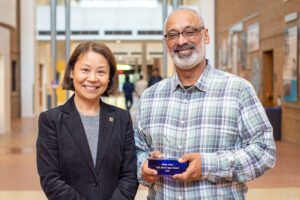Xiao has been working on several projects in Prof. Zetian’s Mi’s group, including micro LED technology and renewable energy.


Xiao has been working on several projects in Prof. Zetian’s Mi’s group, including micro LED technology and renewable energy.
Led by Prof. Becky Peterson, the research focuses on a category of materials important for low power logic operations, high pixel density screens, touch screens, and haptic displays.
The post Scalable method to manufacture thin film transistors achieves ultra-clean interface for high performance, low-voltage device operation appeared first on Michigan Engineering News.
Elaheh Ahmadi, David Blaauw, Michael Flynn, Hun-Seok Kim, Hessam Mahdavifar, and Zhengya Zhang bring their expertise and creativity to this nationwide undertaking in the area of semiconductors and information & communication technologies.
The post Six ECE faculty will help shape the future of semiconductors as part of the JUMP 2.0 program appeared first on Michigan Engineering News.
Dr. Mehdi Saligane, a leader in the open-source chip design community, was among the first researchers to fabricate a successful chip as part of Google’s multi-project wafer program.
The post Open-source hardware: a growing movement to democratize IC design appeared first on Michigan Engineering News.

As part of the U-M Engineering Global Leadership (EGL) Honors Program, Electrical Engineering undergrad Nora Desmond traveled There and Back Again to experience the sustainability culture of New Zealand.

In a partnership with Ecoworks, Pecan Street, and Jefferson East, Prof. Johanna Mathieu is helping create a better process for Detroit homes to benefit from decarbonization, electrification, and renewable energy integration.
The SCISCCO system could better monitor brain and organ metabolism, helping to diagnose concussions, monitor cerebral metabolism in traumatic brain injury patients, and gauge the response of organs to treatments in an operating or emergency room scenario.
The post New non-invasive optical imaging approach for monitoring brain health could improve outcomes for traumatic brain injury patients appeared first on Michigan Engineering News.
Euisik Yoon’s team, led by Sungjin Oh, developed a low-power neural recording front-end circuit to interface with state-of-the-art neural probes.
The post Best paper for a low-power ADC circuit for brain-machine interface applications appeared first on Michigan Engineering News.
A team led by P.C. Ku and Qing Qu has developed a miniature, paper-thin spectrometer measuring 0.16mm2 that can also withstand harsh environments.
The post Miniature and durable spectrometer for wearable applications appeared first on Michigan Engineering News.

Verma credits his distinguished 30-year executive career with leading technology companies, including Savi Technology, Lockheed Martin and 8×8 Inc., to a combination of education, leadership, and luck.